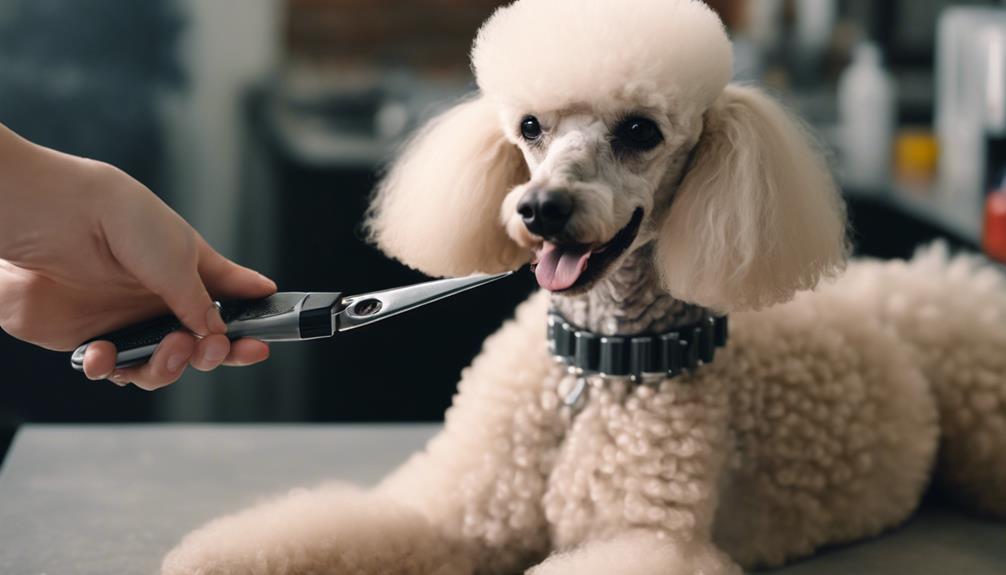To keep your Poodle's skin healthy and free from problems, regular grooming is key. But, did you know that the way you groom your Poodle can make a significant difference in their skin health? By understanding the proper techniques and products, you can effectively prevent common skin issues in Poodles. So, let's explore how you can optimize your grooming routine to ensure your furry companion's skin stays in top-notch condition.
Key Takeaways
- Regular grooming prevents skin problems in Poodles by maintaining coat health.
- Choosing the right tools ensures effective grooming and prevents matting.
- Proper bathing techniques help prevent dry skin and skin irritations.
- Monitoring skin health and nail care is crucial for early detection of issues.
Importance of Regular Grooming
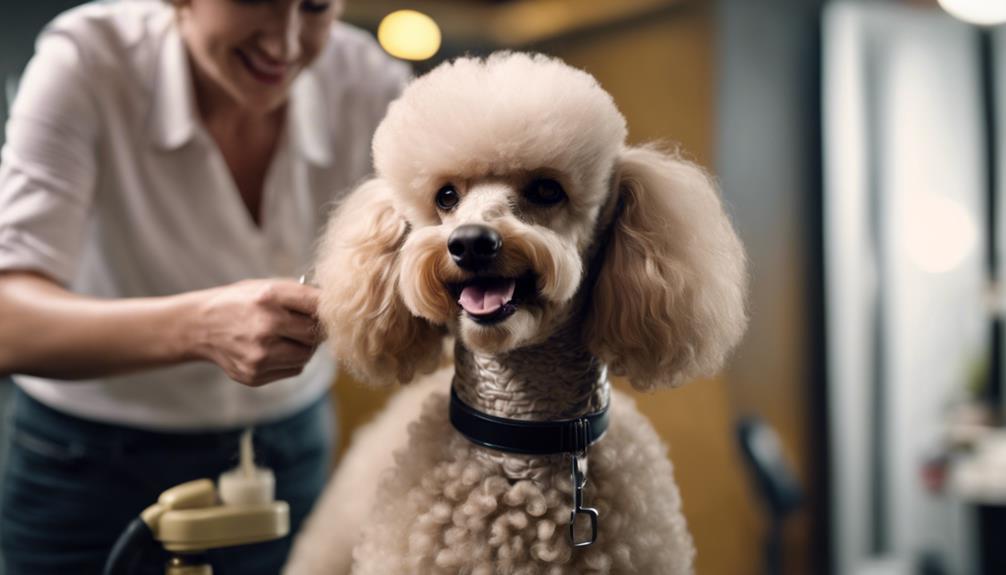
Regular grooming plays a crucial role in maintaining the skin health and overall well-being of Poodles, particularly those with long, curly coats like Standard Poodles. The coat of a Poodle, if not properly groomed, can easily become matted, leading to skin irritations and potential infections. By regularly brushing your Poodle, you can remove dirt, debris, and dead hair, which not only keeps the coat looking neat but also promotes healthy skin and circulation. Grooming sessions offer a prime opportunity to inspect your Poodle's skin for any signs of allergies, infections, or abnormalities that may require attention. Trimming the hair around sensitive areas such as the ears and paws is essential as it reduces the risk of irritation and moisture retention, ultimately preventing skin issues. Additionally, proper grooming aids in distributing natural oils throughout the coat, ensuring the skin stays moisturized and reducing the chances of dryness and flakiness. Remember, consistent grooming is key to maintaining your Poodle's skin health and overall well-being.
Choosing the Right Grooming Tools
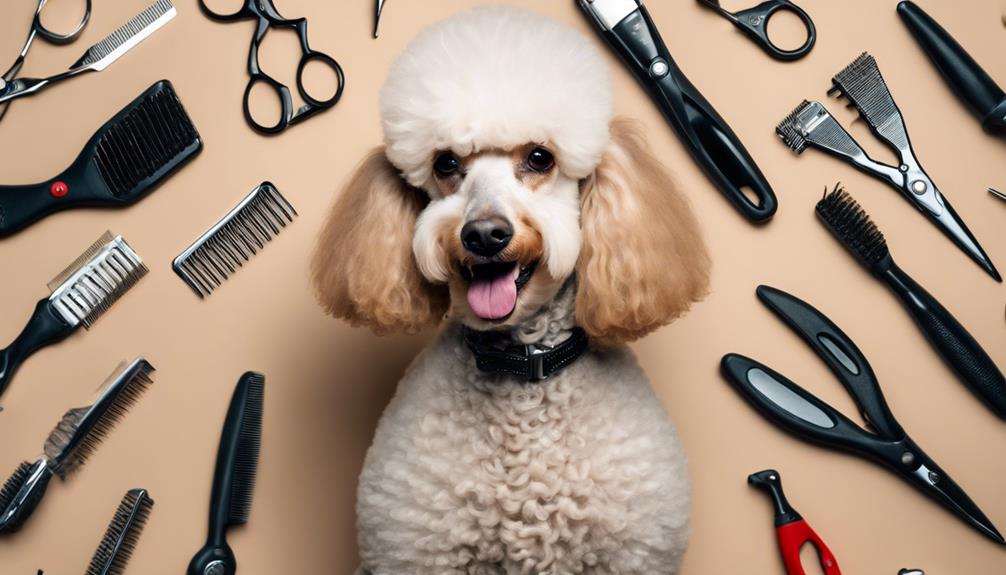
To ensure proper grooming for your Poodle's curly coat, selecting the right tools, such as slicker brushes, stainless steel combs, and grooming shears, is essential. Using high-quality grooming tools is crucial in preventing skin problems, matting, and tangles in your Poodle's coat. Here's why each tool is important:
- Slicker Brushes
- Effective for removing loose hair and preventing mats in the dense coat of Poodles.
- Stainless Steel Combs
- Ideal for detangling and smoothing out the Poodle's fur with their wide and narrow teeth during grooming sessions.
- Grooming Shears
- Specifically designed for pet grooming to ensure precise trimming and shaping of the Poodle's coat without causing discomfort or skin irritation.
Bathing Techniques for Poodles
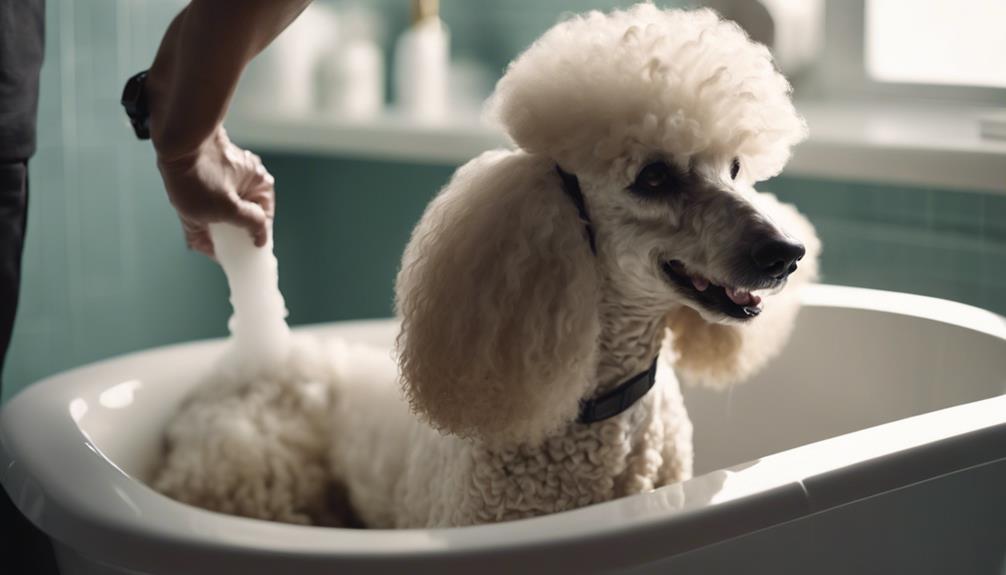
Utilizing appropriate bathing techniques is crucial for maintaining the skin health and coat cleanliness of Poodles. Bathing your Poodle every 3-6 weeks helps prevent skin problems. When bathing, use lukewarm water and a gentle dog shampoo to avoid drying out the skin. Thoroughly rinse the coat to remove all shampoo residue, which can cause skin irritation and itching if left behind. Consider applying a conditioning treatment post-shampoo to keep the coat soft and manageable. After bathing, pat the coat dry with a towel instead of rubbing it to minimize tangles and potential skin damage. This gentle approach helps prevent dry skin and maintains the overall skin health of your Poodle. By following these bathing techniques, you can ensure a clean, healthy coat for your beloved pet while minimizing the risk of skin issues.
Brushing and Detangling Fur
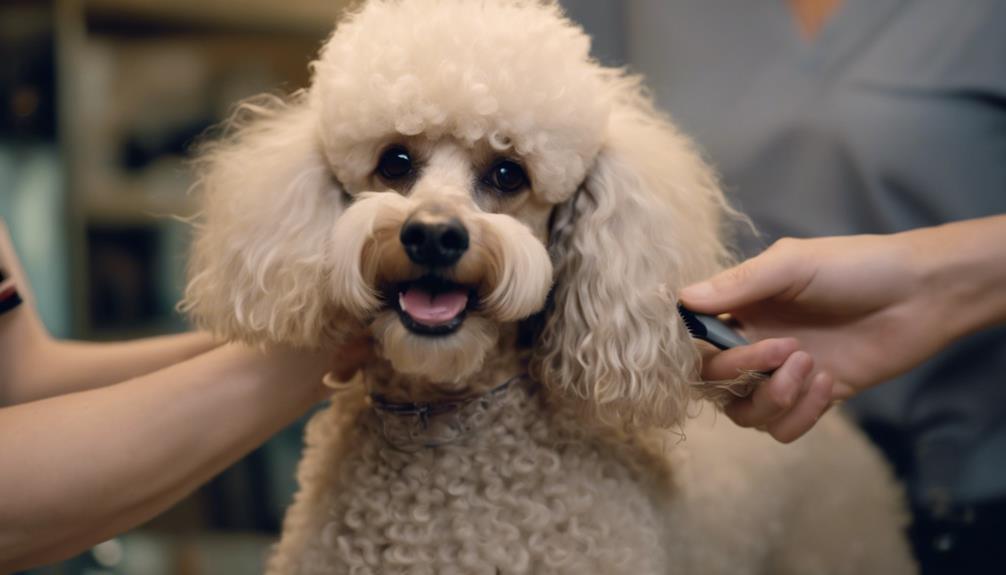
Brushing and detangling fur in Poodles is essential for maintaining their coat health and preventing skin issues. Regular brushing helps prevent matting and tangling of their curly fur, reducing the risk of skin irritation. To effectively detangle a Standard Poodle's dense coat, consider using a slicker brush or comb with rotating teeth. When brushing, start from the bottom of the coat and work your way up to avoid pulling on the skin and causing discomfort.
- Prevention of Matting: Regular brushing prevents matting and tangling of the curly fur, reducing the likelihood of skin irritation.
- Effective Tools: Using a slicker brush or comb with rotating teeth can help detangle the dense coat of a Standard Poodle efficiently.
- Proper Technique: Start brushing from the bottom and work upwards to prevent discomfort and skin irritation, promoting overall coat health.
Trimming and Clipping Practices
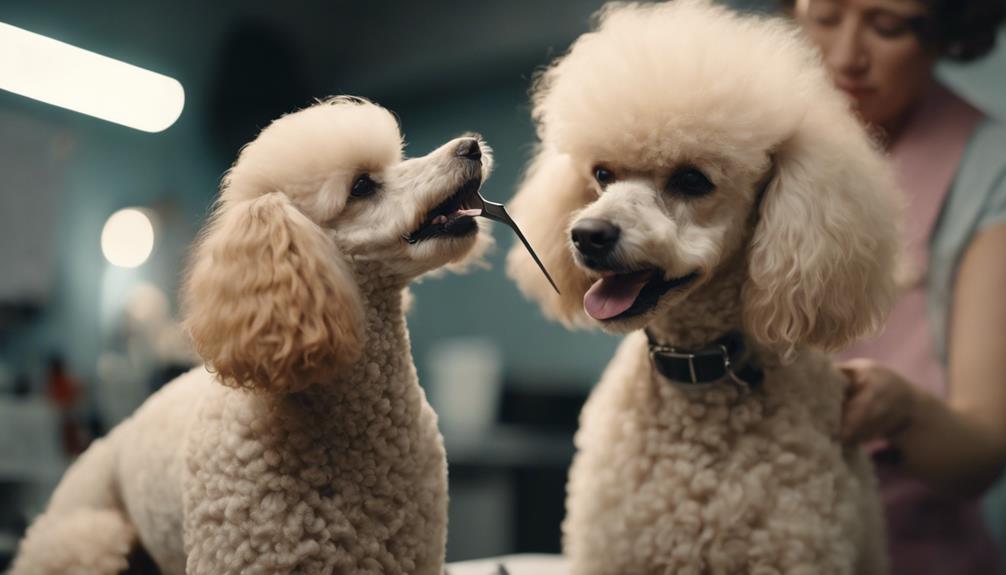
Regular trimming and clipping practices are crucial for maintaining a Poodle's curly coat health and preventing matting and tangling issues. When trimming your Poodle's coat, it is essential to use sharp and well-maintained grooming tools to reduce the risk of skin irritation. Opt for properly sized clipper blades and scissors to ensure a precise trim without accidental cuts or nicks on the skin. By incorporating consistent grooming routines into your Poodle's care regimen, you can help maintain their unique coat style while promoting overall skin health. Following professional guidelines and techniques during the trimming and clipping process can contribute significantly to your Poodle's comfort and well-being during grooming sessions. Remember, proper trimming and clipping practices not only keep your Poodle looking their best but also play a vital role in preventing skin problems and discomfort associated with matting and tangling.
Ear Care and Cleaning Tips
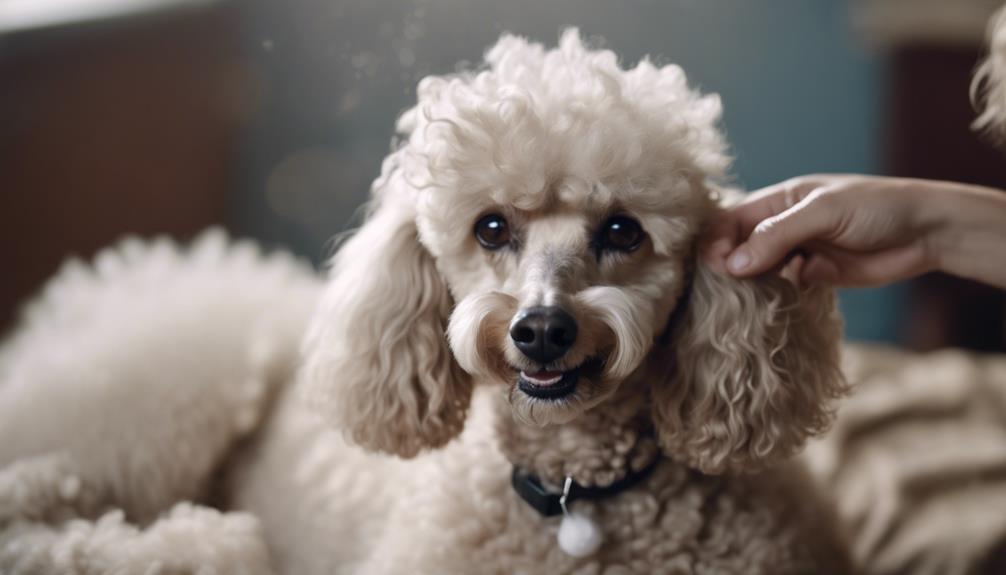
To maintain your Poodle's ear health, focus on ear hair trimming, determine a suitable cleaning frequency, and select gentle cleaning solutions. Proper ear care, including these key points, can help prevent ear infections and discomfort for your furry companion. Remember to be gentle and cautious while cleaning your Poodle's ears to ensure their well-being.
Ear Hair Trimming
Ensuring proper ear hygiene for your Poodle involves regular trimming of ear hair to improve air circulation, reducing the likelihood of ear infections. Excess ear hair can trap moisture and debris, causing bacterial or yeast infections. Here are some essential tips for ear hair trimming:
- Use blunt-tipped scissors or electric trimmers to carefully trim excess hair.
- Trim only the hair visible on the outer ear flap, avoiding the ear canal.
- Seek guidance from a professional groomer or veterinarian for safe and effective trimming techniques.
Cleaning Frequency
When it comes to maintaining the health of your Poodle's ears, an essential aspect to focus on is the cleaning frequency for effective ear care and maintenance. Regular cleaning, about once a week, can help prevent ear infections, buildup of wax, and debris. Use a veterinarian-approved ear cleaning solution and cotton balls to gently wipe the outer ear canal, avoiding insertion of any objects inside. By keeping the ears clean, you can reduce the risk of foul odors, itching, and discomfort for your Poodle. This is particularly important for Poodles with sensitive skin as they are prone to skin allergies, dry skin issues, and itchiness. Frequent baths may exacerbate these problems, making regular ear care even more crucial for Standard Poodles. If you notice any signs of infection or unusual symptoms during cleaning, consult your veterinarian promptly.
Gentle Cleaning Solutions
Select a gentle, veterinarian-approved ear cleaner to safeguard your Poodle's ears from infections and maintain their health effectively. When it comes to cleaning your Poodle's ears, consider the following tips:
- Use a vet-approved ear cleaner: Opt for a gentle solution specifically designed for dogs to avoid irritation or adverse reactions.
- Clean regularly: Make ear cleaning a routine to prevent excess wax and debris buildup, reducing the risk of ear infections.
- Avoid deep insertion: Refrain from using cotton swabs too deeply in the ear canal to prevent pushing debris further in or causing harm.
Nail Maintenance for Healthy Paws
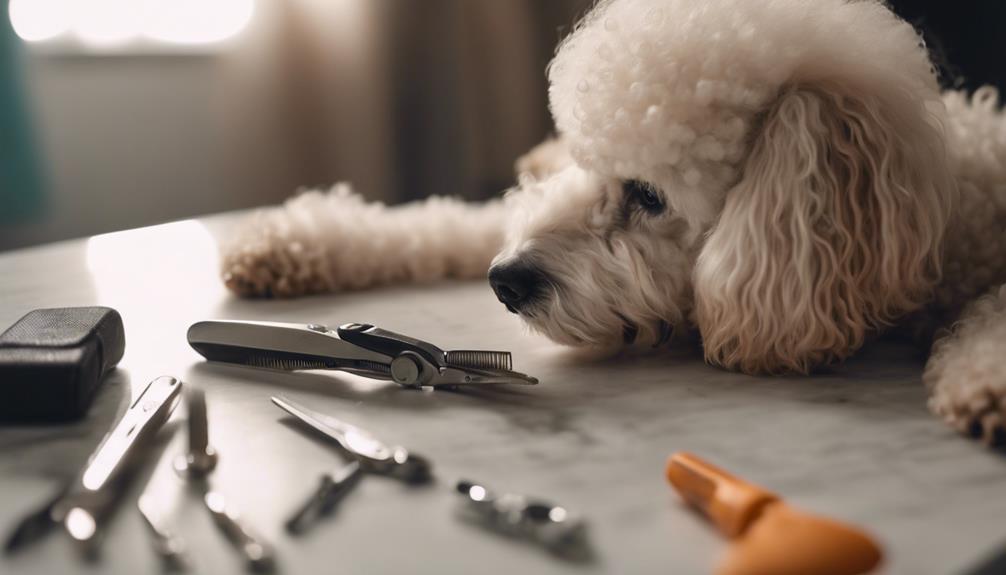
You must trim your Poodle's nails regularly to prevent overgrowth and discomfort. Keep a close eye on their nails to catch any signs of overgrowth early. Regular nail maintenance is essential for maintaining healthy paws and overall well-being in your Poodle.
Trim Nails Regularly
Regular nail trimming in Poodles is crucial for maintaining healthy paws and preventing discomfort and mobility issues. Keeping your Poodle's nails at an appropriate length is essential for their overall well-being. Here are some key points to consider:
- Regular nail trimming helps prevent overgrowth, which can lead to discomfort and difficulty walking in Poodles.
- Long nails can cause joint issues and affect the Poodle's posture and gait over time.
- Trimming nails every 2-4 weeks is recommended to maintain healthy paws and prevent injuries.
Watch for Overgrowth
To maintain healthy paws and prevent discomfort in your Poodle, vigilant observation for nail overgrowth is paramount. Regular nail care is essential to avoid issues such as skin problems, joint discomfort, and improper paw structure. Overgrown nails in Poodles can lead to difficulties walking, splaying of the toes, and posture misalignment. By trimming your Poodle's nails every 2-4 weeks, you can prevent overgrowth and maintain their overall well-being. Proper nail maintenance not only enhances your Poodle's gait but also reduces the risk of injuries and infections. Stay attentive to your Poodle's nails, as addressing overgrowth promptly is key to ensuring their comfort and preventing potential paw-related problems.
Monitoring Skin Health Signs
Monitoring the signs of skin health in your Poodle is crucial to proactively address any potential issues before they escalate. Regularly inspect your Poodle's skin for redness, inflammation, dryness, or any unusual bumps that may indicate a problem. Additionally, keep an eye out for hot spots, excessive scratching, hair loss, or a dull coat, as these can be signs of underlying skin issues. It is essential to observe any changes in your Poodle's skin texture, moisture levels, and overall appearance, as these can provide valuable insights into their skin health. Look for signs of irritation, infections, or allergic reactions that may require prompt veterinary attention to prevent further complications. Early detection of skin health issues through vigilant monitoring allows for timely intervention and can help maintain your Poodle's skin in optimal condition.
Frequently Asked Questions
How Do You Treat Skin Problems in Poodles?
To treat skin problems in Poodles, you focus on skin care through grooming tips. Maintaining a healthy coat, managing allergies, establishing a proper bathing routine, and monitoring skin condition are essential for coat maintenance and overall skin health.
How Can I Prevent My Dogs Skin Problems?
To prevent your dog's skin problems, prioritize a brushing routine for circulation and mat prevention. Moisturize as needed, adjust diet for healthy skin, trim coat, and bathe regularly with gentle products. Careful attention to skin changes is crucial.
What Are Poodles Most Allergic To?
Common allergens for Poodles include beef, dairy, chicken, wheat, and lamb in food. Environmental triggers like pollen, dust mites, and mold can cause skin issues. Grooming products and contact irritants from plastic bowls may also lead to allergies.
Are Poodles Prone to Skin Infections?
Yes, Poodles are prone to skin infections due to their unique coat. Factors like allergies, hormonal imbalances, and parasites can contribute. Regular grooming, identifying irritants, maintaining skin health, and proper diet can help prevent these issues.
Conclusion
In conclusion, maintaining a regular grooming routine for your Poodle is crucial in preventing skin problems. Did you know that up to 70% of skin issues in Poodles can be avoided through proper grooming practices? By using the right tools, techniques, and products, you can help keep your Poodle's skin healthy and free from allergies and conditions. Remember to always monitor their skin health and seek veterinary care when needed to ensure their well-being.
